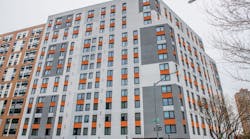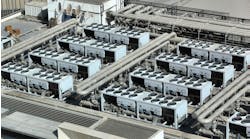A new housing project in New York City is not only affordable to rent—it also saves residents money on energy bills.
Passive House-certified affordable housing development Park Avenue Green is highly insulated and tightly sealed in keeping with the requirements of the certification. These features make the building ultra-efficient and resilient against severe weather.
Here’s how Passive House-certified buildings like Park Avenue Green operate.
What is Passive House?
Passive House is a building certification built around the principles of passive building. These include:
- Continuous insulation throughout the entire envelope without any thermal bridging
- An extremely airtight envelope
- High-performance windows and doors that manage solar gain in both heating and cooling seasons
- Heat- and moisture-recovery ventilation
- Minimal use of space conditioning
The tight envelope and continuous insulation help the building keep conditioned air in and weather out, cutting down on energy waste that would normally result from air leaks. The envelope of 15-story, 154-unit Park Avenue Green is built from concrete masonry units with a brick veneer on the ground floor and an exterior insulation and finish system (EIFS) on the other floors above. Inside the walls are a thick layer of insulation, including:
- Exterior walls: EPS with an R-value of 27.3
- Slab on grade: XPS, R-10
- Foundation wall: XPS, R-20
- Roof: polyisocyanurate, R-50
The windows have a U-factor of 0.14, a shading coefficient of 0.25 and an OITC of 28, adds project architect Mark Ginsberg, principal of Curtis + Ginsberg Architects. That means the penetrations in the envelope are doing their part to help prevent energy waste.
“As important as the R-value of the insulation was, two other things were also important: getting rid of any thermal breaks and a very tight building,” says Ginsberg. “Then, when you make a very tight building, you need to bring in fresh air, so we had energy recovery ventilation units in each apartment to bring in fresh air that was tempered by the exhaust air. It’s important because if you don’t do that, the tight building can lead to sick building syndrome.”
How Park Avenue Green Achieved Passive House
The building required a few creative solutions to earn the certification. The energy modeling revealed that the exhaust ductwork could cause condensation problems within the wall assembly because of the way it was configured, which would result in mold or degrading the facade after the building became operational. The team created a structurally sound insulated assembly to surround the ductwork and fit into the concrete blocks.
“It was the first time any of us had ever done that,” notes Andrea Mancino, executive vice president of Bright Power’s New York division, which provided Park Avenue Green’s energy modeling and other services. “We modeled, consulted with the structural engineer and got the engineer on record involved and came up with a custom solution that prevented a pretty considerable condensation issue.”
The performance of the insulation and the tightness of the envelope created another hurdle—the smallest indoor VRF unit on the market was too big for the building. “The units available only go down to a certain capacity, and that was still too large because we didn’t need as much of a load,” says Mancino. “This project was actually instrumental in the manufacturer putting a smaller capacity unit on the market that was basically specific to Passive House projects.”
Passive House as a Resilience Feature
Pursuing a Passive House certification also means building in resilience features. For example, the insulation itself is a resilience strategy, Ginsberg explains.
“The building is so well insulated that the heat of people in the building will keep it between 50 to 60 degrees F. when it’s 25 degrees out,” Ginsberg says. “Even without power for a few days, you’ll be pretty comfortable in here. If the same thing happens in reverse, if it’s 90 degrees F. during the day and 70 at night, it will be around 80 degrees. If you open the windows at night and then close them during the day, you might be able to do a bit better. But the building, by the nature of being well insulated and very tight, will retain a more even temperature than what’s happening outside.”
Park Avenue Green also has a cogeneration microturbine that doubles as an emergency generator so that in case of a blackout, some of the systems in the building will still run (including the apartments’ refrigerators and one of the elevators).
Maintaining Passive House Buildings
Passive House buildings require careful management once they’re built, especially mechanical equipment like the energy recovery ventilators in each unit of Park Avenue Green.
Multifamily developments come with some extra challenges, like gaining access to the apartments for maintenance and training the occupants in operating the equipment in their unit. Park Avenue Green residents receive a manual and participate in orientation when they move in so they can learn how to use the units for maximum efficiency and comfort.
“You want to make sure that you feel comfortable as an operator or owner going in the units regularly to change filters,” advises Mancino. “Make sure you’re going to have that access. Really think through your population and ability to have access regularly and have a very clear maintenance plan.”
Passive House design can be challenging to attain, like any certification, but the rewards are worth it. The building is modeled to use 45-50% less energy than a building of the same size simply built to code, Mancino says. That saves money for the operator and the residents.
The development was even recognized as part of the Buildings of Excellence Competition by the New York State Energy Research and Development Authority (NYSERDA), which supports the design, construction and operation of low-carbon-emitting multifamily buildings in New York.
“Whether it’s Passive House or just highly energy efficient, these buildings are going to be our future,” says Ginsberg of developments like Park Avenue Green. “The way to reduce our carbon footprint is to make more efficient buildings or retrofit them to make them more efficient.”



